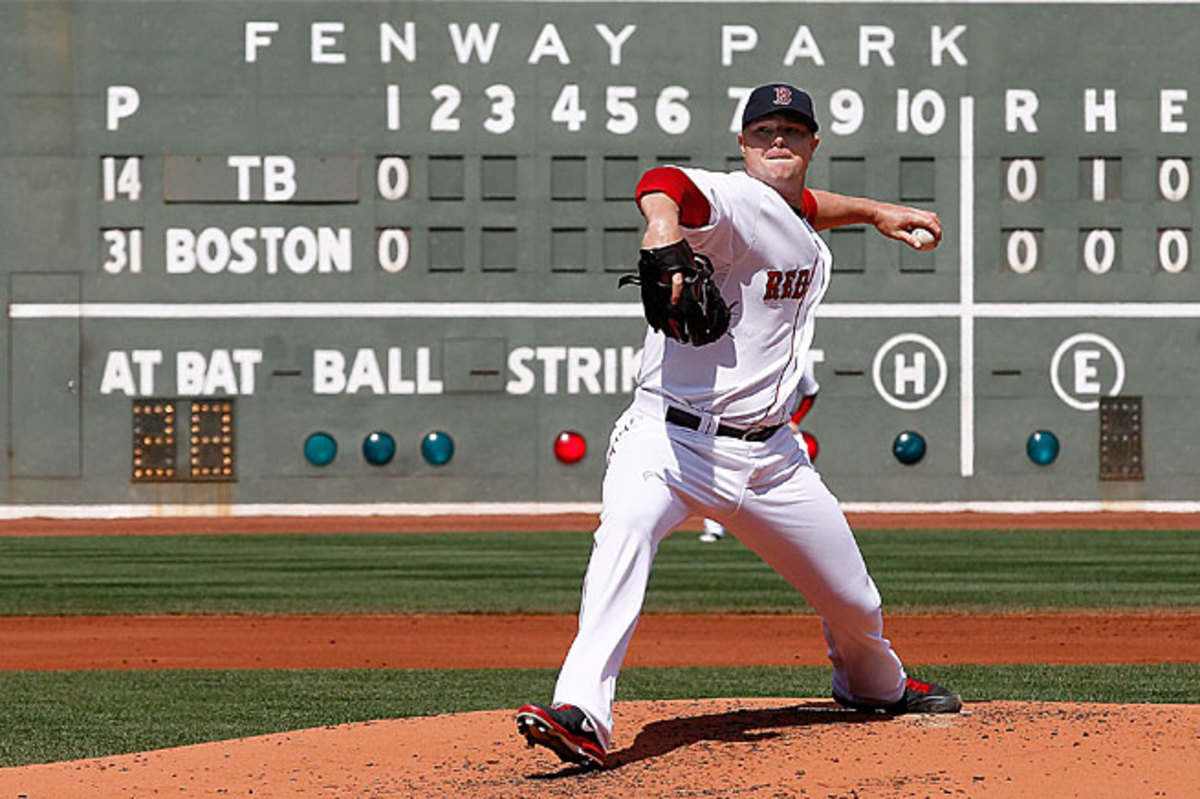Reason for Red Sox turnaround is pretty simple

After a rocky 2012, Jon Lester has regained the form that made him one of the AL's top lefties from 2008-11.
Jim Rogash/Getty Images
The Red Sox wrap up their three-game series in Toronto tonight, and at worst, they'll go through customs carrying an eight-game lead over the offseason's darlings. It's a a far cry not only from last season, but from where I expected them to be just one month ago. Coming off a lost season and committed to an atonal plan of signing older non-star free agents, Boston projected to be better, but not to the tune of a .700 winning percentage and certainly not this much better than the Blue Jays.
The improvement has come entirely on one side of the ball. Through 27 games last year, the Sox were 11-16, having scored 144 runs and allowed 156. This year, they're 19-8 with 145 runs scored...and just 98 allowed. Year over year, the Red Sox allowing two fewer runs per game, and that's the very simple reason why they're leading the AL East.
Now, the immediate reaction is to point to John Farrell's return to Boston as the reason for the change. Farrell was the Red Sox pitching coach from 2007 through 2010 before leaving to manage the Blue Jays for two seasons. However, just three of the pitchers having an impact this season pitched for the Sox under Farrell. Clay Buchholz had a 4.24 ERA during Farrell's time in Canada, versus a 3.68 mark under him -- including his breakout 2010 season. Jon Lester had the worst full season of his career in 2012, and his 2011 performance was a tick below what he'd done before Farrell left. The third holdover, Daniel Bard, isn't a relevant comp, as his 2012 campaign was ruined by the attempt to move him into the rotation. As facile as it seems, Lester and Buchholz do have breaks in their record with and without Farrell on their team's payroll:
Lester and Buchholz, 27 games into 2012, had allowed 53 runs in 69 2/3 innings (6.85 RA/9) over 12 starts. This year, it's 19 runs in 82 1/3 innings (2.08 RA/9). That's an absurd improvement, and it's the biggest reason why the Red Sox are in first place -- their top two starters have pitched like aces, and more to the point, much better than they did at the start of 2012. The two pitchers account for the bulk of the improvement in run prevention:
You might guess that the rest of the gap was the bullpen, but that's not the case. Through 27 games last year, Sox relievers had a 4.48 ERA (I've taken Darnell McDonald's inning in that wild game against the Orioles out of the stats); this year, the number is 4.34, and Boston's bullpen has thrown fewer innings, in part because Lester and Buchholz have been working deeper into games. Last year's Red Sox had no one pitching as well as Ryan Dempster -- 13 runs in 30 innings -- which accounts for some of the remaining difference. On the whole, though, the story of the team's pitching comes down to two homegrown starters pitching as well as they ever have.
Will it continue? Well, no two pitchers in MLB project to combine for two runs allowed per nine innings over a full season. There isn't a lot of luck in Lester's 3.11 ERA -- his FIP is 3.08 and his xFIP 3.57. His BABIP (.274) and HR/FB (6.5%) are a little low, but nothing that jumps off the page in a six-start sample. His season fits in quite nicely with his 2009-10 peak. When Lester was at his best, he was effective against righthanded batters, but last year, he allowed 61 extra-base hits and a .448 SLG to righties. This year, and it's early, he's giving up a .217/.293/.325 line, with a 22/11 K/BB. He seems to be using his hard stuff more against them (70% of his pitches against righties are four-season fastballs and cutters, up from 60% last year, according to Brooks Baseball), and getting away from the softer stuff. Something to watch.
Buchholz has been more fortunate. He's allowed 32 fly balls and just one home run. (He was fortunate in this regard in 2010 as well -- a 5.6% HR/FB). When batters put the ball in play against Buchholz, they're hitting just .248. And when they reach base, they don't come around: Buchholz has stranded an absurd 91% of the runners to reach against him this year. Those numbers will all go up, as will his 1.01 ERA, but a season of 200 innings with an ERA in the low 3.00s is within his reach. Health has been the challenge, not effectiveness: Buchholz, 28, has never made 30 starts or thrown 200 innings in a season and has qualified for the ERA title just twice.
The biggest reason to be optimistic about the 2013 Red Sox was the expectation that the rotation would be a lot better this year as Jon Lester and Clay Buchholz returned to form and, in Buchholz's case, to health. In the season's first month, that is exactly what has happened. It's not likely that the two will combined for a 2.08 RA/9 over the next five months, but if they're a true top two -- both in workload and run prevention -- the Red Sox are as great a threat as any team in the deep AL East.



































